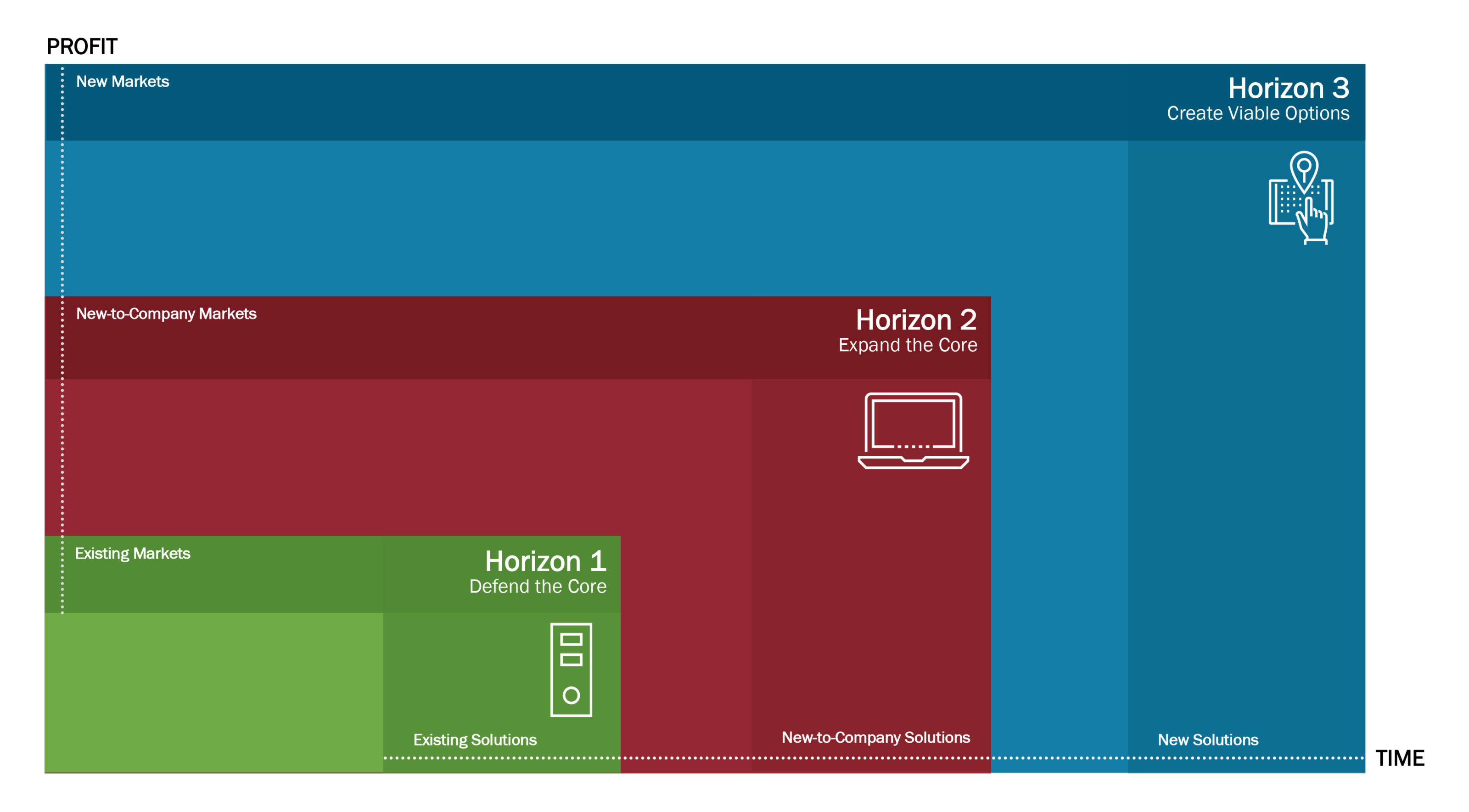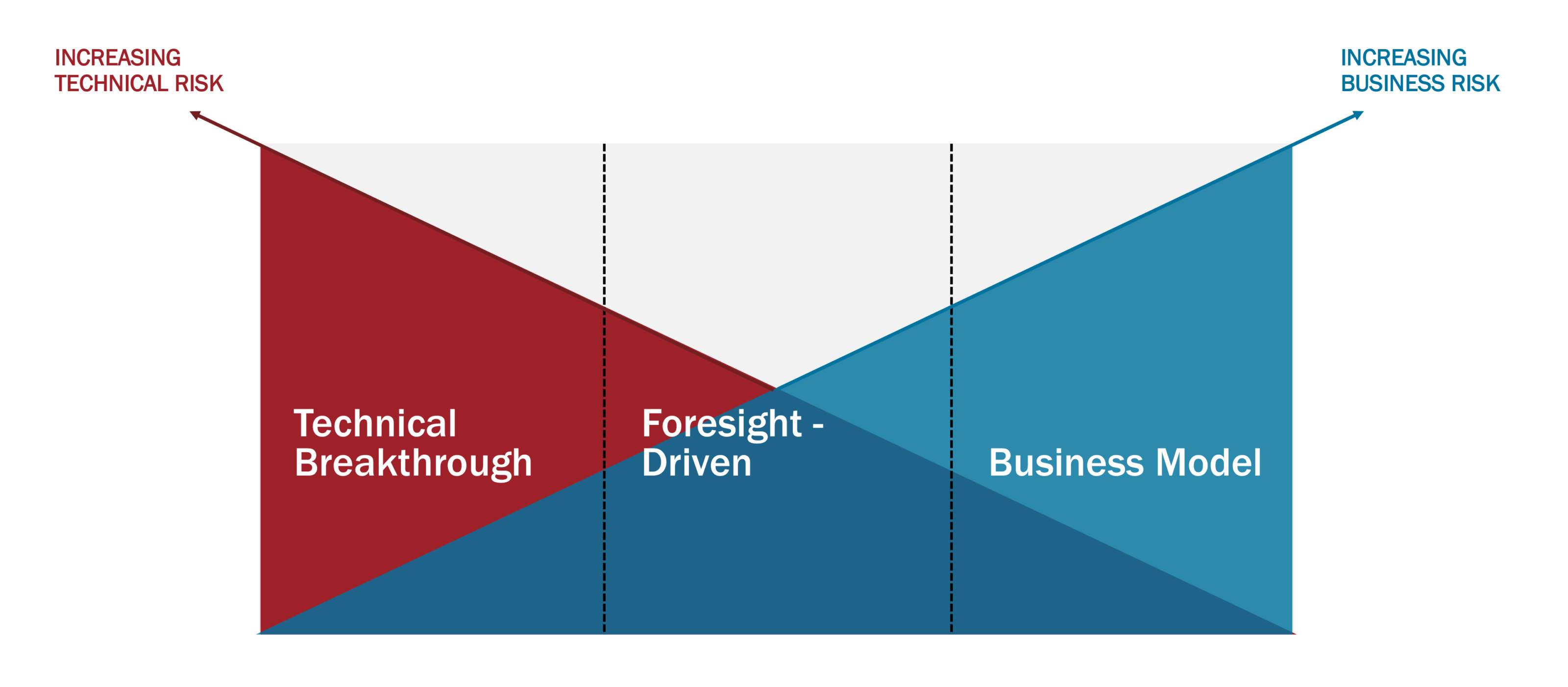Transformative Innovation Involves Risk: But you can pick the type of risk most suited for your organization!
One of the most common messages from the CEO and BOD to a firm’s innovation leader is “we’ve become very good at launching incremental innovations, but we need bigger, more impactful innovations to meet our growth targets.” Before firms jump into the space of bigger, more transformative, innovation there are several conversations that need to occur but rarely do. Years later teams often look back asking “what made us think we could do that in the first place?” Here are three good conversations that should occur before launching a transformative innovation effort:
Do we have a formal process and the culture to explore new-new or Horizon 3 opportunities?

There have been many matrices and graphics used to describe the differences among innovation to support current business, grow emerging businesses and identify “new to the world” business opportunities (Johnson, 1957; Ansoff, 1957; White, 1999). The axis labels change, but the Horizon 1, 2 and 3 construct shown here is representative. An important point is that most innovations of significance can be deployed in multiple horizons but many firms don’t pause to explore the possibilities in a formal fashion. Pretend, for the moment, that it’s the early 1990’s and your firm’s main business is the selling of tower computers. Significantly more powerful computer chips are appearing almost annually. The firm can choose to deploy more powerful processors in 3 ways as illustrated in the figure:
- Stuff more processors into tower computers to keep ahead of the competition in the core business.
- Use the more powerful chips to grow an emerging laptop computer business.
- Hold a brainstorming session looking for new to the world opportunities and create the onboard navigation business we all take for granted today.
To be successful in delivering bigger, more transformative innovation, a firm must have both the culture and processes to routinely explore the new-new or Horizon 3 choice. Unfortunately, most firms are not and therefore miss many opportunities. “We are very skilled at taking big ideas and making then small!” (unnamed CTO).
What kind of innovation are we really talking about?
There are many ways to land results in the different Horizons shown above. Most fall into one of these three innovation categories:
- Technical Breakthrough Innovation: The firm knows it would have a business success with a new offering; but many think the technical challenges are insurmountable. While there are many examples of hero driven single project successes of this type (Liefer, 2000), building an organization to deliver breakthrough results in a sustainable fashion is very challenging for a firm attempting to add this capability to its already healthy incremental innovation engine (O’Connor, 2008). Good project management in this space leverages tools from the agile/scrum toolkit, which are new to many.
- Business Model Innovation: Technological innovations are not always required to be successful in Horizon 3 or new-new innovation. We are surrounded by Horizon 3 business model innovations based on technology available at the time or with minor development. Examples include the i-pod, Amazon and Uber just to mention a few. Research shows (Gassmann, 2006) that all the new business model innovations we see today can be derived as combinations of about 50 basic elements. Yet many companies are so focused on supporting their current business that exploring different business model is not an area of focus, leaving them vulnerable to external disruption. Lean startup project management works well here as the technologies often exist to get a minimally viable product in front of the customer early on.
- Foresight-Driven Innovation: The onboard navigation system is a simple example of Foresight-Driven Innovation. In 1990 a team with the right mission, culture and skills could forecast the future development of faster processors, denser memory and satellite GPS availability to envision early navigation systems in the future. It did not require a breakthrough, just forecasting the natural advancement of technology into the future and looking for opportunities. Michael Treacy once referred to this type of innovation as “Market Positioning” (Treacy, 2004). Of course, President Clinton’s unscrambling of military resolution GPS signals for selected purposes in 2000 advanced the business greatly! Skills required to pursue this form of innovation include strategic foresight, technology forecasting and road mapping. (Crews, 2017; Farrington, 2012; Van Der Heijden, 2005; Roper, 2011; Phaal, 2004,). Playing this sport well requires a culture willing to invest time effort to explore the future in a structured way. Many firms would rather let the future unfold and then react; becoming a fast follower. From a project management standpoint, scrum sprints and lean startup tools can be used to identify the time to act as technologies of interest mature.
When considering a bigger, more transformative, innovation strategy a firm needs to ask which of these are considered in scope.
What is our preferred risk profile?

All these approaches to transformative innovation bring risk, but the risks are different as shown in the figure at the right. Technical Breakthrough Innovation projects are typically taken on with a high degree of confidence that a breakthrough, if achieved, would lead to business success. Business Model Innovations are usually just the opposite. Existing technologies may need to be combined, but the new business model is where most of the risk is taken. Foresight-driven Innovation shares the risk between technical and business. Forecasting the technical future involves risk (though not as much as breakthrough) as does envisioning a future business opportunity. Does your firm’s risk tolerance and risk profile support specific approaches over the others?
Summary
This article is not meant to scare anyone away from building a transformative innovation capability for their firm. But by asking these questions one can identify which, if any, forms of transformative innovation are readily accessible given your company’s current skills, culture and risk profile. Firms seeking bigger innovations should pursue all three, building new capabilities or leveraging more external resources to fill in any capability gaps.
References:

